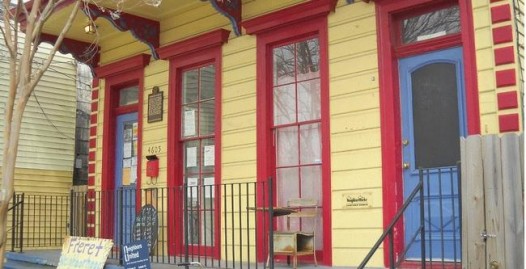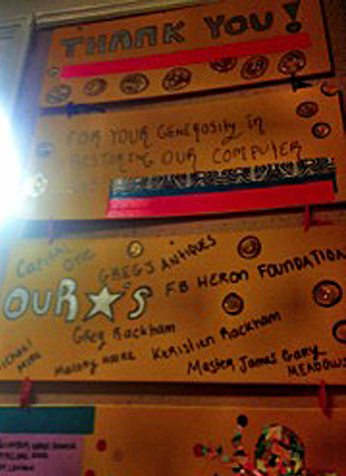By Stephanie Kalikow

The Freret Neighborhood Center: Trying to help residents cross the digital divide.
“Around 80 percent of residents in the Freret and Milan neighborhoods of New Orleans do not have a working computer in their home,” says Yasin Southall, community organizer at the Freret Neighborhood Center.
That’s a big digital divide.
A digital divide, according to Wikipedia, is an “economic inequality between groups broadly constructed, in terms of access to, use of, or knowledge of information and communication technologies.” Since computers play an important role in just about everything, it is almost impossible to imagine life without one. Whether using a computer to apply for a job, complete a college degree, or re-connect with old friends, people of all ages are becoming increasingly dependent on digital access.
New Orleans has faced its fair share of obstacles post-Katrina. But few loom as large as the city’s digital divide, which is one of the country’s most pronounced. According to The Lens, a nonprofit investigative news site, only half of Louisianans subscribe to broadband services; the national average is roughly 60 percent. Additionally, the broadband subscription rates for those living in poorer neighborhoods, such as Freret and Milan, range from 0 to just 20 percent.
Broadband access is a luxury for a majority of poorer residents living in New Orleans. As a result, they are less informed about local and international events. Since the Times-Picayune now publishes a newspaper only three times a week, the importance of Internet access and computer resources for all has become more vital than ever before.

Students in the after-school program wrote a thank you card to all of those who donated computers to the Resource Center.
According to the U.S. Department of Commerce, only 43 percent of Americans who make less than $25,000 a year have home Internet access. In New Orleans, where half the residents make less than $35,000 a year, there is a growing concern about how residents will be able to access important information.
Basic Internet service from New Orleans Cox Cable costs an average $40 a month, or around $500 a year. As Freret Neighborhood Center Project Coordinator Katie Booms explains, “a majority of information is now online, but the problem is that many New Orleanians have no access to computers or Internet based resources.
“People without computers are already being overlooked, and information spreading for these individuals is extremely challenging,” Booms elaborates.
The Freret Neighborhood Center is trying to bridge this digital divide. The center is working closely with residents, especially in its Resource Center, to provide instruction and proper use of computers. In 2007, the year it first opened its doors, the Freret Neighborhood Center sent a survey to thousands of residents inquiring what their biggest neighborhood concerns were post-Katrina. In the 300 responses obtained, the biggest issues were children’s safety, urban blight and lack of computer resources.
Soon after the results were published, schools, businesses, and residents began donating desktop computers to the center.. In the ensuing years, the Freret Neighborhood Center has served as a place where the community can come together, while promoting leadership and development in the Milan and Freret neighborhoods of New Orleans.
“What is this mouse, and what exactly is the difference between a left click and a right click?” Booms says that such seemingly obtuse questions were common when the Freret Center first opened a Resource Center. For the first two years, the center had only four desktop computers. Staffers and volunteers worked one-on-one with residents to help them learn basic, yet essential, computer skills. Residents learned how to pay bills online, apply for jobs, set up e-mail accounts, create and save documents, and build resumes.
A majority of people who use the Resource Center have specific tasks, such as applying for jobs or paying bills online. They often need help getting started. Since there is no time limit on computer use, these residents spend hours in the center building their computer skills, attending resume workshops, and simply catching up on current events.
According to Booms, “The Freret Neighborhood Center believes that everybody deserves access to the Internet and computer-based resources.”
When the Freret Center’s four desktops were stolen in 2010, the organization had to start all over again. With the help of residents, schools, and local businesses, the center acquired six new laptops. Now the center offers free wifi, two fax machines, two printers, and one copy/scanner to anyone living in the Freret neighborhood.
Booms reports that the Resource Center helps three to five people per day, and is open Tuesdays, Thursdays, and Saturdays from 10 a.m. to 2 p.m. Many of its regulars are senior women, who come in to stay active and socialize with other locals. Many of those who frequent the Center do not have computers at home, and look at the Resource Center as a place where they can access the same resources that most people cannot live without.
Last month, Booms and the Freret Neighborhood Center introduced “Learner Web” to its Resource Center. Developed at Portland State University, the free computer program is being offered until June 2013 in cities with large digital divides. The program helps adults complete specific learning objectives, offering a “self-paced instruction, face-to-face or online work with a tutor, or teacher, assessments, and an electronic portfolio.”
With help from the Goodwill workforce, Booms said the Resource Center will likely be able to offer Learner Web for free well past its June deadline. With the program, tutors won’t need to work one-on-one with residents, since they can learn about the computer on the computer.
Freret Neighborhood Center leaders hope that Learner Web graduates will pay it forward, teaching computer skills others while becoming more self-sufficient and independent themselves.
“One of my proudest memories was when a senior who came in and worked with a volunteer two to three days a week, applied for jobs and in one day, got three job offers,” Boom recalls. This success story is one of hundreds the Center is proud to share.
While there is no single solution to the problems of the digital divide in New Orleans exists, such neighborhood initiatives as the Resource Center at the Freret Neighborhood Center has helped the city of New Orleans move closer toward bridging the gap.
“As more and more people realize the importance of closing the digital divide, the more and more New Orleans will continue to grow and successfully rebuild,” Booms says.
This article by Stephanie Kalikow is published as part of a service learning partnership between NolaVie and the students of Dr. Diane Grams’ sociology classes at Tulane University.
 NOLAbeings
Multimedia artist Claire Bangser created NOLAbeings as a portrait-based story project that marries...
NOLAbeings
Multimedia artist Claire Bangser created NOLAbeings as a portrait-based story project that marries...
 Data corner: Adobe Suite (create a PDF, social media graphic, presentation, edit a photo and video
Data corner is where you go to work with analytics and top tech skills. It takes on everything from PERL and SQL to Canva and Sprout Social.
Data corner: Adobe Suite (create a PDF, social media graphic, presentation, edit a photo and video
Data corner is where you go to work with analytics and top tech skills. It takes on everything from PERL and SQL to Canva and Sprout Social.
